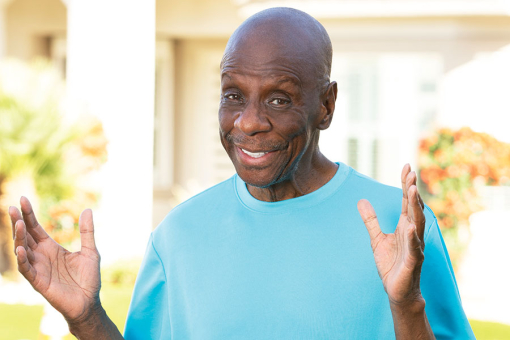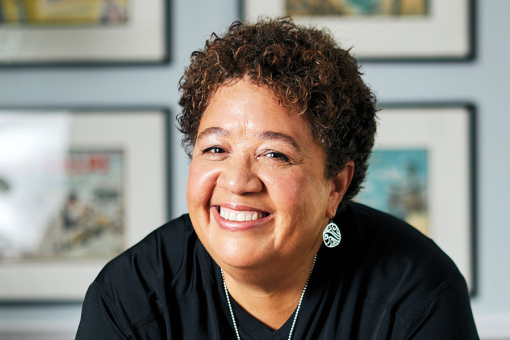From starting out as a lighting engineer on '70s series include Maude and One Day at a Time, to becoming lighting director or director of photography on Good Times, The Jeffersons, Three's Company, Silver Spoons, The Facts of Life, Golden Girls, Home Improvement, Girlfriends and Last Man Standing (to name a few), Morgan has broken barries in the industry and opened doors for others.
One of the first Black directors of photography at a major network, Morgan won his first Emmy, shared with the late George Spiro Dibie, ASC, for outstanding lighting direction on Mr. Belvedere in 1985. He then won seven Emmys during the 1990s as lighting director for Home Improvement, and three more, in 2017, 2019 and 2020, as director of photography for Netflix's The Ranch.
Morgan is co-chairman of diversity, equity and inclusion for the IATSE Local 600 International Cinematographers Guild, and he has helped foster the next generation. "[Lighting director] Tommy Schamp saw something in me, and I can't thank him enough. So I want to pass my experiences on to the up-and-coming," he explains.
In 2020, the American Society of Cinematographers honored Morgan with the Career Achievement in Television Award. In 2022, he was inducted into the Television Academy Hall of Fame, the first director of photography to be so honored.
He was interviewed in September 2022 by Adrienne Faillace for The Interviews: An Oral History of Television, a program of the Television Academy Foundation. The following is an edited excerpt of their conversation. The entire interview can be screened at TelevisionAcademy.com/Interviews.
Q: What did your parents do for a living?
A: My mom worked for UCLA as a pathologist. Dad was a professional musician, played with Cab Calloway and traveled the world. He was Esquire 's bass player of the year, 1945. I followed in that vein, playing stand-up bass through junior high school. And then when I got into high school, I rocked out with my guitar bass. I thought my calling was music all through high school and in college.
Q: Where did you go to college?
A: I went to Santa Monica City College and LACC. I took graphic arts and printing, architecture, photojournalism. ... In graphic arts I was doing color separation. That's what I thought I was gonna get into — printing and color separation. But I still wanted to do my music.
Then around 1978, a friend of mine from high school called and asked if I wanted to take a job in the mailroom over at KTTV. The band wasn't making money, so I said, "Yeah." I got the job and could still do my music at night.
As I did my mail rounds, I met people from different departments. I would stop onstage and try to figure out what they were doing. Norman Lear was just beginning with Maude and Good Times.
I was there for about seven months. I met the people at the front desk, and they would tell you if there were availabilities. I thought I might want to get into audio because of my music background, so they put my name on a list in engineering, and about two weeks later they called and said, "We have a lighting job."
I said, "I want to do audio."
"Do you want to work?"
I said, "Yes, I want to work."
"Bring a glove and a wrench."
"Okay."
I kinda knew some of the guys that were doing lighting. They had the plans laid out on the table. From my architecture background, I could read the plans and figure out where lights should be hung. I said, "Okay, that's this over here, and that's where the set goes."
They said, "Can you read these?" I said, "Yeah."
And so it began — the wheels started to turn. We rigged the stage, and then the lighting director came out, George Schamp, and the stage went black. Then they turned the light on, and it was perfect — the nose created the shadow, you got the diamond and the cross-key. It was perfect. And I said, "I kinda like this" — the whole process, and the people that are involved, and what it took to get it done.
Then they kept calling me back. And they put me on staff there. The lighting consultants were George and Tommy Schamp, and Tommy showed us the basics of lighting — he came from the days of Playhouse 90 — shooting live TV with a dramatic feel.
We were changing over two shows per stage. All in the Family and The Jeffersons were on the same stage. We would shoot Monday, Tuesday, then turn the stage over for the other show. I was working six days a week on a variety of different stages. Then I became a gaffer and would do the nighttime turnarounds on Wednesdays. You'd be an electrician three days a week, and an LD [lighting director] two days a week. Being on staff, you would also do local television, talk shows, variety specials. I did that for about a year and a half, working my three-point lighting, lighting different skin tones — it was a great learning experience.
Q: What did lighting different skin tones entail?
A: Norman Lear had a variety of shows — Good Times, All in the Family, Diff'rent Strokes, One Day at a Time ... so you had all these different skin tones, and we didn't really know what was going to work. For Good Times we used softer Fresnel [lights], and that worked out. One year we went with all hard light, then we started to use color with hard light. Two days later, you'd go over to One Day at a Time, and with the skin tones on that show, you wouldn't light with hard light.
Then, on The Jeffersons you had a mixed cast, some very dark people and very light-complected folks, and the older cameras didn't have the latitude that cameras have now, where you can put two people in the same picture, and it can be dealt with. Then, we had to do it with lighting — more with somebody of color, less with a person of lighter skin. You'd sit around with your fellow LDs and talk about this stuff — 'cause we were all gonna deal with it at one point.
Q: How did you become a director of photography?
A: Norman Lear moved over to Universal. It was 1983, I think, when Tommy came over from Universal and asked me, "Do you want to get your film card?"
I'd been thinking about bringing more of the black-and-white film look into the sitcom age, because they were very flat, very bright, and I wanted to create more depth. So I said yes.
He said, "Okay, give your resignation, and I'll meet you Monday morning on Stage 43 at Universal."
I walk up to Stage 43, Tommy put his hand around my shoulders and said, "Just go in there and do what you do. I know you're gonna be great." Patted me on the back, turned around and walked away. I walked through those doors, and it was like the first day of grammar school.
Fortunately, I'd worked with our director, Jack Shea, on The Jeffersons. This was Silver Spoons. I was walking in as a cinematographer, director of photography, and I really didn't know what was happening. I didn't know how much you have to be in charge, be the big boss. And the show wasn't set up properly. I could hear Tommy in the back of my head: "Do what you have to do to fix it."
I said to the producers, "Listen, I need two hours."
Jack said, "Okay."
I said, "Shut off everything; we're starting from scratch." My crew was really incredible. After that, it started to run smoother. They gave me two shows — I started doing Gloria, too.
And at lunchtime I went to different stages just to see what everybody was doing, why they were doing it. By the end of the first year, I had made a quantum leap with knowledge — how to bring other qualities of lighting into the four- camera world.
Q: You did the pilot of Mr. Belvedere.
A: Yes. 20th Century Fox came in with a pilot called Mr. Belvedere, and they brought a lighting consultant, George Dibie. George had a way of communicating and working with color. He introduced me to filtration. He was using his Dibie Net: you take the lens off, put the filter on, put a rubber band around the back side, put it back in — that's old- school. That's what they used to do in the '30s and '40s — a lot of the stuff that you would see was in glass, with an actual stocking behind the lens. That was a great experience. And he submitted it for an Emmy, and we won for the pilot.
Q: In addition to Mr. Belvedere , you've worked on dozens of pilots over the years — Moesha, The Nanny, Hot in Cleveland, All-American Girl, Golden Girls — this is just a small sampling. What do you enjoy about working on pilots?
A: You're able to set the look of the series. Golden Girls, that whole concept of them being in Florida — I work from outside-in. Where the light sources are — I use that as motivation. You can play with night, day, sunset. If the writers put it on paper, you're responsible for making it happen.
Q: Tell us about your work on Benson.
A: Okay. A couple secrets.
Q: Yes!
A: Robert Guillaume was a really incredible actor and person. But I always thought that even though it was Benson's show, they didn't light Benson. [Guillaume, the star of the series, was Black.] They lit everybody else, but they didn't light Benson. I got an opportunity to do two seasons, and I started to light the show for him. I pulled him off to the side; I said, "Robert, I'm gonna be doing some different things for ya." I felt that I helped Robert. It's a little more work — it's not a generic setup. I made sure that where he stopped and delivered those lines, he got a little bit extra.
Q: How did you come up with your setup for Home Improvement?
A: I met with [creators] Matt [Williams] and Carmen [Finestra] and David [McFadzean], and they told me about this show that they're doing and how there's this neighbor [Wilson], and you don't ever see his face. John Pasquin, the director for the pilot and the first couple seasons, is a real creative and fun person. We talked about having a jib — as Wilson is over the fence and looking down on Tim, you've got to get the perspective over his shoulder. And then the other cameras — you get in your flat twos, crosses. So now you've got five cameras.
I said, "We'll light the show around the jib, put it where we need it." And they came up with the concept of transition shots within the show, starting from scene to scene in pose. We would go from a flat shot, and then cut to an overhead upstage and do a fun move and start the scene. That was part of the look of the show.
There were a lot of challenges, but we were having a good time. I got six Emmys out of the show.
Q: You got seven, actually.
A: Seven? Yeah. It was always fun to do. I always thanked the crew — I can't do it by myself, and you're only as good as your crew. And you're only as good as your last shot. I always try to expand my space within the space given. If I can bring technology into our environment, and I don't have to work more than twelve hours, that's a win!
Q: By the 2000s, how much had technology changed from when you started in the '70s, in terms of cameras, lighting, color correction?
A: In the 2000s, we started going into digital cinematography. They were still trying to figure out the frame rate and frame size. Girlfriends and a variety of other shows were phasing out sixteen millimeter — then it went to the F23, which was a digital camera, but not digital capture. Then we went into digital capture. The cameras are faster, the chips are better.
Q: Going back to specific shows you worked on — how did you come up with your lighting choices for The Ranch?
A: When I met with [creators] Don Reo and Jim Patterson, they said they wanted this show to be the darkest sitcom on air. I said, "What?"
They said, "Yeah, we wanna do something new." They were dead serious about it.
I was going, "We're shooting multi-cam, not single-cam."
They said, "Yes, but this is what we want."
We would rehearse with the stage work-light so everybody could get their marks, and then they would say, "Okay, ready for the Don Morgan pass." I'd turn the lights off, and man, it was dark onstage, but everybody was on their marks.
Netflix was on board. The producer was on board. The director wanted more light, but we work for the showrunner, and they allowed me to play.
Q: You won another three Emmys for The Ranch.
A: Yeah. That show's been so much fun. I learned a lot. I took a lot of what I learned early in my career and was able to play with it — different lighting setups, using bounce boards, using boxes ... and I was getting visits from all kinds of DPs who wanted to see how I was getting away with such low light levels. I loved walking through and explaining, "This is what happens when you're here," and I would see their minds clicking. It's great.
Q: How has cinematography for television changed since you first started?
A: The equipment has progressed, and the personnel behind the scenes has started to progress. I want to make a change — I like to have a crew that represents real life. I'm happy to see women and women of color behind the lens. It's slowly getting better.
Q: What do you enjoy about working with the next generation of cinematographers?
A: Tommy Schamp saw something in me, and I can't thank him enough. So I want to pass my experiences on to the up-and- coming. It reaffirms what I've learned to be able to explain it to somebody, and if I see something that might help them, I'll let them know. I don't want to preach too much that "this is the way to do it," but, "Here's some information you might be able to use."
Q: In a few months, you're going to be inducted into the Television Academy Hall of Fame.
A: Yeah. All I can say is, thank you very much. It's incredible.
The contributing editor for Foundation Interviews is Adrienne Faillace.
Since 1997, the Television Academy Foundation has conducted over 900 one-of-a-kind, long-form interviews with industry pioneers and changemakers across multiple professions. The Foundation invites you to make a gift to the Interviews Preservation Fund to help preserve this invaluable resource for generations to come. To learn more, please contact Amani Roland, chief advancement officer, at roland@televisionacademy.com or (818) 754-2829.
To see the entire interview, go to: TelevisionAcademy.com/Interviews.
This article originally appeared in emmy magazine issue #9, 2023.














